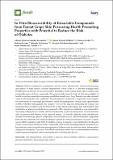Por favor, use este identificador para citar o enlazar a este item:
http://hdl.handle.net/10261/228664COMPARTIR / EXPORTAR:
 SHARE SHARE
 CORE
BASE CORE
BASE
|
|
| Visualizar otros formatos: MARC | Dublin Core | RDF | ORE | MODS | METS | DIDL | DATACITE | |

| Título: | In vitro bioaccessibility of extractable compounds from tannat grape skin possessing health promoting properties with potential to reduce the risk of diabetes |
Autor: | Fernández-Fernández, Adriana Maite; Iriondo-DeHond, Amaia CSIC ORCID ; Nardin, Tiziana; Larcher, Roberto; Dellacassa, Eduardo; Medrano-Fernandez, Alejandra; Castillo, M. Dolores del CSIC ORCID | Palabras clave: | Anti-inflammatory α-glucosidase Antioxidants Diabetes α-amylase Bioaccessibility |
Fecha de publicación: | 2020 | Editor: | Multidisciplinary Digital Publishing Institute | Resumen: | Diabetes pathogenesis encompasses oxidative stress, inflammation, insulin malfunctioning and partial or total insulin secretion impairment, which leads to a constant hyperglycemia. Polyphenols are known to possess bioactive properties, being Tannat grape skin a natural and sustainable source of these compounds. The present study aimed to find out the bioaccessibility of health-promoting molecules composing a multifunctional extract from Tannat grape skin obtained under hydro-alcoholic-acid conditions. The identification of phenolic compounds in the samples was performed by ultra-high performance liquid chromatography tandem mass spectrometry (UHPLC-MS/MS). Subsequently, the samples were in vitro digested mimicking the human oral gastrointestinal conditions and the bioactivity of the digest (antioxidant, anti-inflammatory and modulation of glucose metabolism) was assessed. Effect on glucose metabolism was estimated by measuring carbohydrases activity and the functionality of glucose transporters of small intestine cells in presence and absence of the digested extract. Flavonoids, phenolic acids and phenolic alcohols were the major phenol compounds detected in the extract. The bioaccessible compounds protected the intestinal cells and macrophages against the induced formation of reactive oxygen species (ROS) and nitric oxide (NO). In addition, glucose transporters were inhibited by the digested extract. In conclusion, the bioaccessible compounds of the extract, including phenols, modulated key biochemical events involved in the pathogenesis of diabetes such as oxidative stress, inflammation and glucose absorption. The extract was effective under prevention with co-administration conditions supporting its potential for either reducing the risk or treating this disease. | Descripción: | This article belongs to the Special Issue Grapes and their Derivatives in Functional Foods. | Versión del editor: | https://doi.org/10.3390/foods9111575 | URI: | http://hdl.handle.net/10261/228664 | DOI: | 10.3390/foods9111575 | E-ISSN: | 2304-8158 |
| Aparece en las colecciones: | (CIAL) Artículos |
Ficheros en este ítem:
| Fichero | Descripción | Tamaño | Formato | |
|---|---|---|---|---|
| invidia.pdf | 813,36 kB | Adobe PDF |  Visualizar/Abrir |
CORE Recommender
PubMed Central
Citations
10
checked on 11-may-2024
SCOPUSTM
Citations
12
checked on 09-may-2024
WEB OF SCIENCETM
Citations
12
checked on 26-feb-2024
Page view(s)
105
checked on 16-may-2024
Download(s)
84
checked on 16-may-2024

